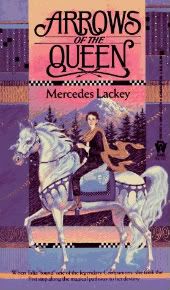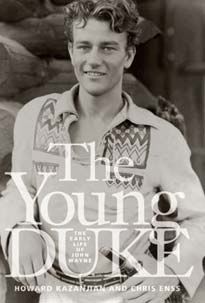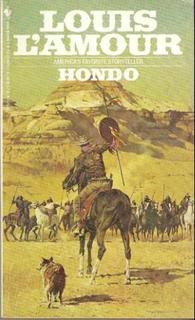I have the bad habit, as a reader, of sometimes dismissing a book by its cover. Literally. And of making sweeping generalizations.
For instance: I don't like fantasy, because all fantasy is cheesy and has sworcerers and all the women in fantasy novels are dressed up in outfits like Princess Leia's slave girl bikini and sometimes there are magic crystals and all the made-up lands have weird languages and unpronounceable names. This particular sweeping generalization kept me from giving many decent, relevant fantasy novels a try for the longest time. I didn't read
Lord of the Rings until I was in college, for Pete's sake!
During the five years in high school and college that I worked in a bookstore, these beliefs were both supported and eventually broken down. I was always fascinated, when shelving in the fantasy section, by how similar so many of the books looked and sounded, and by how truly terrible the cover art was on so many of them. One such book I always noticed and puzzled over was
Arrows of the Queen, by Mercedes Lackey.
 Arrows
Arrows was the first book in a trilogy set in a kingdom called Valdemar. I loved the idea of the heroine being a small, scared girl with curly brown hair and brown eyes. But my brows went up at the cover art (
pastels, I noticed with horror), and they nearly reached my hairline when the back cover informed me there were sentient horses.
Now, I'm a horse-crazy girl. I was when I was six and I remain one today. But I've never gotten into talking, thinking horses as an entertainment source---no
Mr. Ed, no Artax* or Fledge** or Shadowfax***. Even Black Beauty never resonated with me the way The Black**** did. So the idea of sentient horses had me pretty leery, and for the longest time, whenever I shelved a new copy of
Arrows, I would give it a lingering glance and then put it away.
Once I realized my time in the bookstore was coming to an end, I went on a bit of a book-buying spree. I bought a tall stack of books using my precious, long-lamented employee discount, and one of those was
Arrows of the Queen. I know, crazy, right? But I just couldn't dismiss it from my mind--something about it stuck with me, in spite of the pastels and talking horses. I sat down with it one night and pretty much did not move from the spot until I finished it.
Okay, it's a WONDERFUL series. I reread all three books (second is
Arrow's Flight, third is
Arrow's Fall) at least two to three times a year--there's something about the world Mercedes Lackey has created and the people she fills it with that really resonate with me. Additionally, she writes incredibly strong female characters and these are badly needed in fantasy literature (there are much more of them today than there were 25 years ago, when
Arrows first came out). Talia, the heroine, becomes one of the most important people in the kingdom, which is ruled by a just, capable queen. No shrinking violets, they.
The plot is as thus: Talia is a 13 year old girl from one of Valdemar's remote, puritanical border sectors. Her people are strict, joyless, and think girls should be uneducated and restricted to marrying and birthing children. Talia dreams of a life beyond that, but can't see how it will ever happen. More than anything, she wants to be a Herald, a messenger of the Queen. Then, circumstances force her to run away from home, and while on the road, she's met by a Companion (the sentient horses). Companions are the mounts of Heralds--they are intelligent beings, and while they don't literally speak out loud, their bond with their riders is such that they can speak mentally to each other. Companions, in effect, choose their riders, and only people with a selfless sense of duty and desire to serve will be Chosen, because being a Herald is a thankless, dangerous job. In return, Heralds and their Companions share incredible bonds---to have a Companion is to have a lifelong, built-in best friend who loves and trusts you no matter what.
Talia is Chosen by Rolan, who bears her away to the capital city of Haven. There, Talia discovers that she is to become the Queen's Own Herald, the highest ranked Herald of all---one who will serve as the Queen's most trusted counselor. She spends the rest of the book in school and training, learning to grow into her responsibility and position, overcoming adversity, and learning for the first time what it's like to be a part of a community that loves and supports her. Truly, beyond the relative thinness of the plot in this first book, the characters are what keep me rereading it. I LOVE the community of Heralds, I miss them when I'm not reading it, and I wish I could be friends with them myself.
Another book that I'd rolled my eyes at numerous times and yet somehow ended up purchasing in that last, frenzied year of employment was
Alanna: The First Adventure, by Tamora Pierce.

While
Arrows was more geared towards adults,
Alanna was solidly young-adult. I was kind of turned off by the book's mention of magic, by the implied inclusion of a talking cat (sigh), and by the staggering realization that there were (at the time) twelve books in the series. So I spent four years not giving it a chance and one month frantically reading the twelve books as quickly as I could. Humble Pie, table one.
The twelve books can actually be divided into three separate series. In chronological order, they follow the adventures of Alanna (
The Song of the Lioness quartet, books 1-4), Daine (
The Immortals quartet, books 5-8), and Keladry (
The Protector of the Small quartet, books 9-12), three girls who live in the kingdom of Tortall. I actually read Alanna's first, then Keladry's, and Daine's last--and while it didn't confuse me to read them somewhat out of order, I'm sorry I did because it kind of spoiled a particular romance for me.
Alanna of Trebond is a young 11 year old girl being sent to learn magic, while her twin brother Thom is being sent to learn knighthood. The only thing is, Alanna would rather be a knight and Thom would rather be a mage. They switch places, and Alanna, disguised as a boy, travels to the capital. There, she spends three years as a page learning the art of warfare---everything from weapons, to history, to law, to equitation, to courtly graces. It's not until the end of her time as a page that it's discovered she's a girl, and chaos erupts. Girls can't be knights, naturally, it's unthinkable. She must prove that she has every right to be there, and that she's just as capable as a boy of protecting her kingdom. She must endure incredible hardship and prejudice to do so, but of course she's triumphant.
Daine's series is connected to Alanna's, but definitely separate. She's a young girl with the gift of communicating with animals, and her series follows her education in building and utilizing this gift, and how she uses it to serve the kingdom. The characters from Alanna's series show up periodically in it--Alanna is a full-blown knight by now, as well as married and with children--but the primary emphasis of the series is on Daine and her gift.
Kel's series is my favorite of the three. After Alanna's success in completing her training, and her near-mythological status as a fearsome warrior, the laws of the kingdom are changed so that girls can become knights as well. Keladry is the first girl to take advantage of it, but she finds out that in spite of Alanna's success, the feelings and prejudices of the kingdom are still against her, and she has to fight even harder than Alanna to prove herself. I found Kel to be the most personable of the three heroines (though all are enjoyable), but I think I liked her series the best of all because of the wonderful relationships she has with those around her---her family are supportive, the knight she serves as squire was one of my favorite characters from the Alanna series, and there's a heartwarming reversal of sentiment in one of the more virulently unfriendly characters (warning: have kleenex handy).
Anyway, this long-winded post is really just my way of saying: Don't judge a book by it's cover, or assume all fantasy novels are the same. Sometimes you just need to give them a chance.
*
The Neverending Story, by Michael Ende
**
The Magician's Nephew, by C. S. Lewis
***
Lord of the Rings, by J. R. R. Tolkien
****
The Black Stallion, by Walter Farley
















